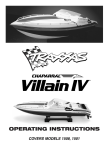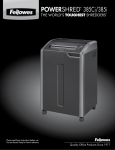Download Traxxas 3810 Baby Toy User Manual
Transcript
OPERATING INSTRUCTIONS MODEL 3810 REV 031202 Thank you for purchasing a Traxxas Blast offshore racing boat. This manual contains the instructions you will need to operate and maintain your new Blast boat. Look over the manual and examine the Blast carefully before running it. If for some reason you think the Blast is not what you wanted, then do not continue any further. Your hobby dealer absolutely cannot accept a Blast for return or exchange after it has been run. ▼ INTRODUCTION: Most importantly, use good common sense when you are near water to avoid mishaps such as slipping on a muddy bank. Always observe water safety rules and regulations. REQUIRED EQUIPMENT: To operate the Blast, you will need the following equipment, all of it should be available from your hobby shop. 1. Small Phillips head and flat screwdrivers (for adjustments) 2. “AA” size batteries for your transmitter(8) 3. 7.2V, 6-cell rechargeable battery pack (1700mah is best) 4. Charger for the battery pack 5. Model paints for detailing the drivers WHERE TO RUN: Please read all of the operating instructions and precautions before attempting to drive your new Blast. These instructions are written with the assumption that this is your first radio-controlled model. Even if you are an experienced R/C enthusiast, it is important for you to read and follow the procedures in this manual. Pay special attention to the mechanical and safety precautions outlined in this manual. If you have any questions about your new model, then call Traxxas’ technical support line at 1-888-TRAXXAS (1-888-872-9927 U.S.A. residents only. Outside the U.S. call 972-265-8000). Technical support is available Monday through Friday, from 8:30am to 9:00pm central time. We hope that you will enjoy your Blast for many hours to come. PERSONAL SAFETY PRECAUTIONS: If the precautions are followed, and your Blast is operated sensibly and with care at all times, it is exciting, safe and fun for you and your spectators. Failure to operate your Blast in a safe and responsible manner could result in property damage and injury. Please make sure to follow the instructions and adhere to the precautions. ▼ Do not drive the Blast at night. ▼ Never, under any circumstances, operate the Blast in any water where people are swimming or wading. The Blast is very fast and could cause injury if it should collide with anyone. ▼ Because the Blast is controlled by radio, it is subject to radio interference from many sources that are beyond your control. Since radio interference can cause momentary loss of radio control, always allow a safety margin in all directions around the boat in order to prevent collisions. ▼ Do not reach underneath the rear of the Blast, the propeller could spin unexpectedly. Always pick up the boat from the front or the side. ▼ Because of the many dangers involved with any body of water, Traxxas recommends that you never try to wade or swim to retrieve the boat. Page 5 of this manual outlines safer methods for boat retrieval. ▼ The Blast is not intended for use by children without a responsible adult supervising. Every precaution outlined in this manual should be followed to help ensure safe operation. Traxxas is not liable for any loss or damages, whether direct, indirect, special, incidental, or consequential, arising from the use, misuse or abuse of this product including any chemical or accessory required to operate it. Due to the high-performance nature of the Stinger 20-turn electric motor, it will become extremely hot during use. Do not touch the motor when installing and removing battery packs. Select a body of water (must be at least 10-inches deep) which is calm and free of debris, tree stumps, moss, etc. Also, find a clean, stable area of shoreline to launch from. Be aware that some ponds restrict the use of model boats. Always choose a launch site which is downwind so that the wind and waves will drift the boat back to you if it should ever flip. Do not run the Blast in salt water. RADIO SYSTEM TERMINOLOGY: Please take a moment to familiarize yourself with these radio system terms. Channel - The 27 MHz frequency band is divided into 6 channels so that up to six models can be operated simultaneously. Each channel is referred to by its flag color and channel number, as shown below. Channel Frequency Band Flag Color Traxxas Part No. 1 26.995 Brown 2031 2 3 27.045 Red 2032 27.095 Orange 2033 4 27.145 Yellow 2034 5 27.195 Green 2035 6 27.255 Blue 2036 Clearing Your Frequency - A routine, verbal check to make sure nobody else in your area is operating on the same channel. Always clear your frequency by calling out your channel number before operating your model. Wait or move to another area if your channel is already being used. Crystal (X-tal) - The plug-in device that determines which channel the radio system will operate on. For each channel, there are two crystals, one for the receiver and one for the transmitter. Of those two crystals, the one marked with the lower number (.455 MHz lower) must be inserted into the receiver. Frequency Band - The radio frequency used by the transmitter to send signals to your Blast. All Traxxas RTR models operate on a 27 MHz frequency band. Neutral Position - The standing position that the servos seek when the transmitter controls are at the neutral setting. NiCad - Refers to rechargeable, nickel-cadmium batteries. The most economical choice, since they may be recharged up to 500 times. Receiver - The radio unit inside your Blast that receives signals from the transmitter and relays them to the servos. Servos - Small motor units in your Blast that operate the throttle and steering mechanisms. Transmitter - The hand-held radio unit that sends throttle and steering instructions to your Blast. Trim - The fine-tuning adjustment of the neutral position of the servos, made by turning the throttle and steering trim knobs on the face of the transmitter. Electronic Speed Control - Controls the speed of the boat. Fully digital-proportional for precise throttle control at all speeds. RADIO SYSTEM ADJUSTMENT: Opening the Hatch - The top hatch is held secure with a rubber band. To open the top hatch, pull it up and rotate it. This will provide access to the battery compartment and on/off switch. For full access to the radio compartment, unhook the rubber band from the top hatch. Your radio system was pre-adjusted before it left the factory however, the adjustment should be checked prior to running the Blast. These instructions are for Traxxas radio systems only. If you installed your own radio, refer to your radio system’s instructions. ▼ PREPARING TO RUN: Installing Transmitter Batteries- Your transmitter uses 8 “AA” size batteries. They should be alkaline dry cells, or nicad rechargeable batteries. The battery compartment is located in the back of the transmitter. To remove the battery door, push down and slide in the direction of the arrow. Be sure that the switch is turned off before installing the batteries. Insert the batteries into the battery compartment making careful note of the polarity. Now, slide the battery door back in place. ▼ Always turn your transmitter on first and off last. This procedure will help to prevent your Blast from receiving stray signals from another transmitter, or other source, and running out of control. ▼ Push the switch inside the boat to the “on” position. The steering servo should jump and move to its idle (neutral) position. Keep fingers and obstacles away from the propeller. ▼ Operate the steering control on the transmitter (channel 1). Check for rapid operation of the steering servo and that none of the steering mechanism is loose or binding. If the servo operates slowly, check for weak batteries. Adjust the “steering trim” control on the transmitter to adjust the servo so that the outdrive is pointing straight out from the back of the boat. Also, check to be sure that the outdrive does not turn more in one direction than in the other. If you cannot align the outdrive, refer to the section “Centering Your Servos.” ▼ There are six possible channels, numbered 1 through 6. Each is represented by a color. Look at the crystal plugged into the back of your transmitter to determine which channel your boat is assigned to. Operate the throttle trigger on the transmitter to ensure that the throttle is operating properly. If the propeller is spinning when you plug in the battery, or it doesn’t seem to reach full speed, then refer to the directions for adjusting the electronic speed control. ▼ Setting Up the Antenna - You must install the antenna mast (tube) before you operate your Blast. You’ll find the plastic antenna tube and tip in the bag with your manuals and documentation. The radio system should be range-tested before each session of running. With the radio system on, have a friend carry the boat away from you a distance equal to the maximum range you plan to operate the the Blast. At distance, once again test for complete radio control. Never attempt to run the Blast if the radio appears to be malfunctioning in any way. 1. Locate the black antenna wire that exits the receiver cover. 2. Pull the wire straight with your fingers and then insert the end of the wire into one end of the antenna tube. Push the wire all the way through the antenna tube. 3. Pull the remaining wire through the antenna tube, and then insert the base of the antenna tube into the molded post on top of the receiver cover. 4. Fold the remaining antenna wire over the top of the tube and secure it with the antenna tip. 5. On the transmitter, always fully extend the telescoping antenna when running your Blast. Make a habit of holding the transmitter so that the antenna points straight up. Installing the Battery Pack- The battery installs in the bow (front) of the boat. Remove the foam block and slide the battery pack into the battery tray. Slide the foam block back into place to secure the battery. The Blast is not designed to use 7-cell (8.4 volt) battery packs. TRANSMITTER CONTROLS: Throttle Neutral Adjust - A switch (located to the right of the throttle stick (channel 2)) that controls the amount of desired forward and reverse travel of the throttle trigger. It should stay in the down position as shown in the drawing (right). If you change this adjustment, your transmitter throttle trim will have to be reset. In extreme cases, the electronic speed control will have to be readjusted. See “Electronic Speed Control Adjustment.” Throttle Trim/Steering - Adjust the throttle trim control so that the motor in the Blast does not run after the battery pack is plugged in. Adjust the steering trim so that the Blast will drive straight without veering to the left or right. Each time you prepare to run your Blast, you must clear your frequency to be sure no one else in the area is using the same channel as you. ELECTRONIC SPEED CONTROL ADJUSTMENT: The Traxxas electronic speed control is a fully-proportional, forwardonly unit. It has two adjustments; the neutral control and the proportional control. Use a small screwdriver to adjust the controls. CAUTION: The adjustment controls will only turn 1/4 turn left or right from center. Do not turn the controls past their stops or they will break. Use a light touch when making adjustments. Controls damaged by overturning them past their stops will not be covered under the warranty. Adjusting the Neutral Control - First, set the Blast on its stand, turn on the transmitter, and plug a fresh battery pack into the speed control. Set the throttle trim slider on the transmitter to the middle of its range. If the Blast’s motor is running, gently turn the neutral control right or left until the motor stops running and the L.E.D. is off (neither green or red). 2) Check the wiring for any frayed wires or loose connections. 3) Check the tightness of the grub screws in the collars on the steering linkages and in the universal joint yokes (connecting the outdrive to the driveshaft and the driveshaft to the motor). Threadlocking compound can be applied to these screws to prevent them from loosening. Center / Turn 1 4 STOP / Turn 4) Check the mounting of the receiver and servos. STOP 5) Check the rubber driveshaft seal for cuts and tears. Do not attempt to run the Blast if this seal is damaged. 1 4 PRO RT PO I A ON L TR EU A L N ELECTRONIC SPEED CONTROL Adjusting the Proportional Control - After setting the neutral control, move the throttle lever on the transmitter to full throttle. Now, carefully adjust the proportional control right or left until the motor is running at its fastest speed and there is a strong green light emitted from the L.E.D. CENTERING YOUR SERVOS: 6) Check the tightness of the propeller. Hold the u-joint and turn the propeller clockwise until it’s fingertight. Visually inspect the prop for nicks, dings and warpage. Replace if damaged. 7) Check the operation of the radio system, especially the condition of the batteries. 8) Visually inspect the hull for any cracks, damage or possible leaks. 9) Check for deterioration of the rubber band which holds the top hatch. Whenever your radio system has been removed for service or cleaning, the steering servo must be recentered prior to installing the radio system in the model. If the radio system is already installed in the boat, disconnect the servo horn from the servo. Connect the steering servo to channel 1 on your receiver and the electronic speed control to channel 2. The white wire on the servo cable is positioned towards the crystal. Nothing connects to the “batt” terminal on the receiver. ▼ Select a body of water (at least 10 inches deep) which is clear of moss and grass. Do not drive the Blast in rough, choppy water or in high wind (more than 15 MPH). These conditions could cause your Blast to flip over. ▼ The Blast’s steering is very sensitive, a slight input on the steering control will have a large effect on the boat. When the boat is in open water, adjust the steering trim on the transmitter until the boat travels in a straight line on its own. (Note: The blast will only travel in a straight line on its own when it is heading straight into or away from the wind. Crosswinds will require constant steering input to maintain a straight course.) ▼ To prevent spin outs, avoid sharp turns at high speed. ▼ Turn off the electronic speed control switch followed by the transmitter. The servo is now ready to be installed. Be careful not to move the servo shaft when installing the steering linkage. Readjust the electronic speed control as described in the previous section. DRIVING THE BLAST: Always be ready to reduce the throttle if the Blast appears to be unstable or “chine walking” (rocking violently from side-to-side). Always reduce the throttle when turning, especially in rough water. Jumping the Blast or towing anything with it should not be attempted. ▼ Place fresh “AA” batteries in the transmitter and turn the power switch on. Slide the throttle and steering trim adjustments to the center position. Connect a fresh 7.2V battery pack to the electronic speed control and turn the power switch to the ON position. The servo will automatically jump to its center position. Return the Blast to shore at the first sign of weak batteries (Blast will begin to slow and the controls will become sluggish). VISUAL INSPECTION: Visually inspecting the mechanical integrity of the Blast should be done before each run. 1) Normally, very little water will accumulate inside the boat. Empty any standing water out of the boat between runs. Drill a small hole (1/16 in.) in the front of the boat to drain the water. Do not drain the water out of the back of the boat (near the radio system). Drill a small hole here Cavitation - If the Blast is running at full throttle but is only barely moving forward then the propeller is cavitating. Try advancing the throttle slowly to get the Blast on plane. If you are having trouble with cavitation, check the propeller for nicks or tangled debris. The Blast’s propeller is specially designed for its application, therefore, it’s very sensitive to any changes or modifications. If the prop is damaged it should be replaced. ADJUSTMENTS: STORAGE: Adjusting the Trim Angle - The outdrive strut on the Blast will allow you to adjust the trim angle of the propeller. The trim angle changes how high the bow of the boat rides out of the water. Setting the trim angle correctly will provide the maximum speed and efficiency from the Blast. Drain all water out of the Blast and thoroughly dry it before you store it. Store the Blast with the hatch cover removed so that any remaining moisture will have an opportunity to evaporate. PAINTING THE HULL: If you wish to paint your hull some other color than the factory white, choose your paint with caution. Only use paint made for plastic models (available from your hobby dealer). Test the paint on an inconspicuous and non-critical area before painting the entire boat. The paint on the bottom must be smooth to prevent a loss of performance. WARRANTY SERVICE AND REPAIR: As the outdrive is trimmed up, the bow (front) of the boat will ride higher causing the boat to run slightly faster, however, it will be more unstable in the wind. Do not trim the outdrive up on windy days or when running in choppy water. If the trim is set to high, then the bow will bounce up and down (“porpoise”), and the prop may begin to cavitate. As the outdrive is trimmed down, the bow of the boat is lowered thus increasing the wetted surface of the boat. This will slow the Blast slightly but, stability and control will be improved. Experiment with this adjustment to find out what works best for your particular conditions. Adjusting the Outdrive Shaft End Play - There should be a slight amount of shaft end play in the outdrive housing. To adjust the end play loosen the grubscrew on the u-joint yoke (see drawing). Pull the propeller shaft until there is no more than 1mm of distance at arrow 2 in the drawing. Retighten the grub screw. BOAT RETRIEVAL: If the Blast accidentaly flips over and fills with water, it is equipped with foam flotation to help prevent it from sinking. Traxxas does not recommend ever trying to swim or wade to retrieve a boat. If you have chosen your launch sight carefully (downwind), the blast will probably drift back to you on its own. If there is no wind, you will need a tennis ball and a length of string. Tie the tennis ball securely to one end of the string and then throw the ball over the drifting boat. Pull the ball in and try to entangle the boat in the string. Pull the boat back slowly to shore. If only the bow of the boat remains visible, try using a fishing lure with many hooks and a fishing pole. Try to snag the lip of the upper deck or drive mechanism with the hooks. ▼ Keep the Blast clean of accumulated dirt and oil. ▼ Re-oil the motor bushings before each day of running. Use an oil made for electric motors such as 3-in-1 OilTM. ▼ MAINTENANCE: Periodically re-oil the bushing in the outdrive housing and the driveshaft tube. The oil-hole for driveshaft tube is located underneath the electronic speed control. Defective Merchandise Policy - Traxxas assumes responsibility for its products and will repair or replace any defective product at its sole discretion. Please contact Traxxas directly should a problem arise with one of our products. Customer and dealer service hours are from 8:30am to 9:00pm central time. Customer service can be contacted toll-free at 1-888-TRAXXAS (1-888-872-9927), and outside the United States at 972-265-8000. The Traxxas fax numberis 972-265-8011. E-mail support is available 24 hours a day at [email protected]. GENERAL PRODUCT WARRANTY: Electronic Components - Traxxas electronic components are warranted to be free from defects in materials and workmanship for a period of thirty (30) days from the date of purchase. Electronic components consist of the radio system (transmitter, receiver, servos, switches, and receiver battery holders), and any other Traxxas electronic component. See the additional limitations that apply. Chassis and Engine - The chassis consists of all remaining parts of the model that are not considered electronic or part of the engine. A Traxxas product is considered to be a race oriented, hobby-class model. We have made every effort in component design, material selection and assembly to make our products as durable as possible. Because our products are high-performance hobby-class models that operate at a much higher level of performance than a “toy,” they require periodic maintenance, and are intended to be used in high performance applications over an extremely wide range of running conditions and situations. No warranties are expressed or implied that cover damage caused by normal use or wear, or cover or imply how long any chassis or other part will last before requiring replacement due to wear. Even under the most ideal conditions, parts will wear from use and occasionally require replacement. Chassis parts are only covered against manufacturer’s defects in materials, workmanship or assembly when they are new (before being used). If any component is found to be defective, incorrectly made, or incorrectly assembled within the warranty coverage time period (where applicable), it will be repaired or replaced at Traxxas’ sole discretion. This will be done within a reasonable time period and free of charge. If you believe a defect in materials, workmanship, or assembly was not apparent when the product was new and only became evident after the product was used, then please call us at 1-888-TRAXXAS. We stand behind our products and reputation and pledge to do our best to make sure you are satisfied with your Traxxas product. Limitations - Any and all warranty coverage does not cover replacement of parts and components damaged by abuse, neglect, improper or unreasonable use, crash damage, water/excessive moisture, chemical damage, improper or infrequent maintenance, accident, unauthorized alteration/modification or items that are considered consumable. Traxxas will not pay for the cost of shipping or transportation of a defective component to us. NON-WARRANTY SERVICE: Traxxas offers an extended electronics warranty plan. It requires no payment up front. You only pay when you need the service. Please see the “Traxxas Lifetime Electronics Service Plan” in your documentation package. Traxxas Extended Lifetime Electronics Plan - After the expiration date of the warranty period, Traxxas will repair electronic components for a flat rate of $15.00 U.S. plus $5.00 U.S. for shipping and handling. The electronic products covered by this extended service plan include Do not send the entire model, only the damaged component. The package shipped to Traxxas should be insured to cover the value of a new replacement. Traxxas cannot be responsible for items lost in transit to Traxxas. Follow the guidelines in the section Preparing Merchandise for Shipment elsewhere in this document. International Customers - International orders must be paid by credit card (MasterCard, Visa or Discover). Actual shipping charges will apply and are usually higher than $5.00 U.S. If you want to approve the shipping charges prior to your product being returned, then please supply a valid e-mail address and request approval of actual shipping charges on the form. HOW TO OBTAIN WARRANTY & REPAIR SERVICE: Call us first! Before you begin the process of obtaining warranty or repair service, please call us at 1-888-TRAXXAS and speak with one of our friendly and knowledgeable support technicians. Often a product might appear defective, or to malfunction, only because it is being used improperly or requires a simple adjustment. One phone call to our experienced support staff just might get you back running quickly and easily! When you return a product to Traxxas, please provide the following: • Proof of purchase indicating the date purchased • Any applicable forms • Any required payment • Return address • Daytime and evening phone numbers • E-mail address • Brief description of the problem Follow the guidelines in the section Preparing Merchandise for Shipment elsewhere in this document and return the item to Traxxas. If the component is found to be defective, it will be repaired or replaced at no charge and returned. Any needed repairs that are not covered under warranty will be estimated on an individual basis, prior to any work being done. PREPARING MERCHANDISE FOR SHIPMENT: Following these guidelines will help you save on shipping costs and assist our service department in expediting your repair. Remove all batteries from the model including NiCd packs and AA batteries. If the transmitter is being returned, remove the “AA” batteries. Clean the model before returning it to avoid additional cleaning fees. Reassemble undamaged components to avoid additional repair charges. ▼ Allowing water, moisture or other foreign material to enter the component or get onto the PC board. Exceeding the maximum input voltage of the electronic component. Removing the JST (stock) battery connector(s). Using the same type and (or) gender connectors on a speed controls motor and battery connections. Cross connection of the battery/motor. Reverse voltage application. Exceeding the published motor limits for electronic speed controls. On the EVX, using a motor with fewer than 19 turns, or using a motor other than a 550 size. Incorrect installation or wiring. Components worn from use. Short circuiting the heat sinks on electronic speed controls. Using an electronic speed control without the heat sinks. Removing the noise filter capacitors from the stock motors. Not installing capacitors on replacement motors (Recommended three .1µF [50V] each). Splices to the input or switch harnesses. Disassembling the case. Excessive force when adjusting, pressing, or turning any of the controls. Tampering with the internal electronics. Incorrect wiring of an FET servo. Allowing exposed wiring to short circuit. Any damage caused by crash, flooding or act of God. 1) Full payment in the form of a credit card number (MasterCard, Visa or Discover) or money order (including shipping and handling). 2) Completed Extended Lifetime Electronics Plan form. ▼ ▼ ▼ ▼ ▼ ▼ ▼ ▼ ▼ ▼ ▼ ▼ ▼ ▼ ▼ ▼ ▼ ▼ ▼ ▼ ▼ Specific Limitations - The Traxxas warranty does not cover damage to electronic components caused by: Procedure - The electronic component being returned for repair should be removed from the vehicle and returned to Traxxas, along with: ▼ Limitations of Liability - Traxxas makes no other warranties expressed or implied. Traxxas shall not be liable for any special, indirect, incidental, or consequential damages arising out of the assembly, installation, or use of their products or any accessory or chemical required to use their products. By the act of operating/using the product, the user accepts all resulting liability. In no case shall Traxxas’ liability exceed the actual purchase price paid for the product. Traxxas reserves the right to modify warranty provisions without notice. All warranty claims will be handled directly by Traxxas. The Traxxas warranty gives the customer specific legal rights and possibly other rights that vary from state to state. The customer is required to fill out and return the registration card enclosed with the product as a condition of the coverage and performance of the warranty. All dollar amounts stated are in United States dollars. The term “lifetime” shall refer to the product’s production life at Traxxas. Traxxas is not obligated to provide upgraded products at a reduced rate when a previous product’s production cycle has ended. ▼ Hobby Dealer’s Role - All warranty claims are handled directly by Traxxas. Traxxas does not authorize dealers to make over-the-counter exchanges or refunds for Traxxas products that have been used. Traxxas will make the sole and final determination if a product or component can be covered under warranty. electronic speed controls, transmitters, receivers, servos and battery chargers. Motors and mechanical speed controls are not covered. The covered repairs are limited to non-mechanical components that have NOT been subjected to abuse, misuse or neglect. Products damaged by intentional abuse, misuse, or neglect, may be subject to additional charges. ▼ ▼ ▼ ▼ ▼ ▼ ▼ ▼ DO NOT SEND batteries, chargers, instruction manuals, bodies or any other accessories you use to run your model. This will save shipping cost and prevent the possibility of those items becoming lost. Traxxas shall not be liable for accessory items lost during the repair process. If your model is equipped with Traxxas or aftermarket accessories and has a replacement value higher than a stock new model, consider removing the accessories prior to shipment. In case of loss during transit from Traxxas to you, Traxxas can only be responsible for the replacement cost of a new stock model. Ship your package insured for the new replacement value of the product. Traxxas cannot be responsible for items lost in transit from you to Traxxas. Package the product in the most efficient size box possible. Loose product in oversize boxes can increase the risk of loss or additional damage in route to Traxxas. If possible, avoid the use of foam packing peanuts. If peanuts must be used, please place the item to be repaired in a sealed bag. Include all the documentation and forms required to repair the model. Along with a brief description of the problem. Include a daytime and evening phone number or e-mail address that the service department may use to contact you with questions or estimates regarding the repair. Include a return shipping address. It is surprising how often this is overlooked. We must have a physical address in order to return your product. It must be a street address. We cannot ship to Post Office boxes. Ship Items, freight prepaid to: Traxxas Attn: Service Department 1100 Klein Road Plano, Texas 75074-3721 ADDITIONAL NON-WARRANTY CHARGES: Additional charges can result from the following. • The product being returned for warranty service should be cleaned of excess dirt and grime accumulations that would hinder repair. Excessively dirty models with large amounts of caked-on mud and oily grime may be subject to an additional cleaning charge of $25.00(US) before repairs can proceed. Avoid this potential charge by cleaning the model before returning it for service. • “Basket cases” of disassembled models returned for warranty service may be subject to additional fees for reassembling components not related to the warranty repair, if necessary to allow the repaired product to be adequately tested. Standard repair fees are currently $45.00/hour, billed in 15-minute increments with a one-hour minimum. To avoid this charge do not disassemble the model before returning it for service Customer and dealer service hours are from 8:30am to 9:00pm central time 1-888-TRAXXA S. E-mail support is available 24 hours a day at [email protected] Troubleshooting support, how-tos and technical information is available anytime from our website at www.Traxxas.com. The Traxxas online community (message forum) is a great, searchable reference for many topics. It’s available anytime from the Traxxas website at www.Traxxas.com


















